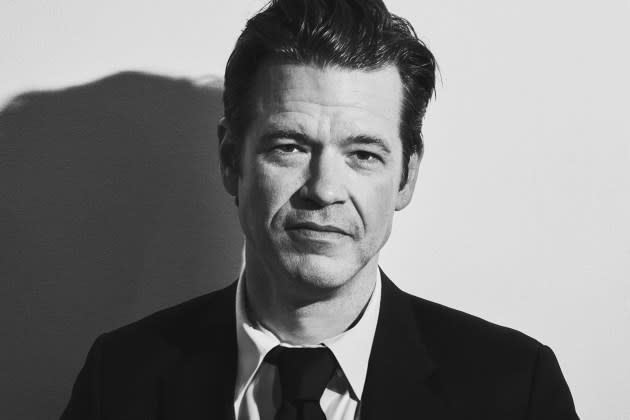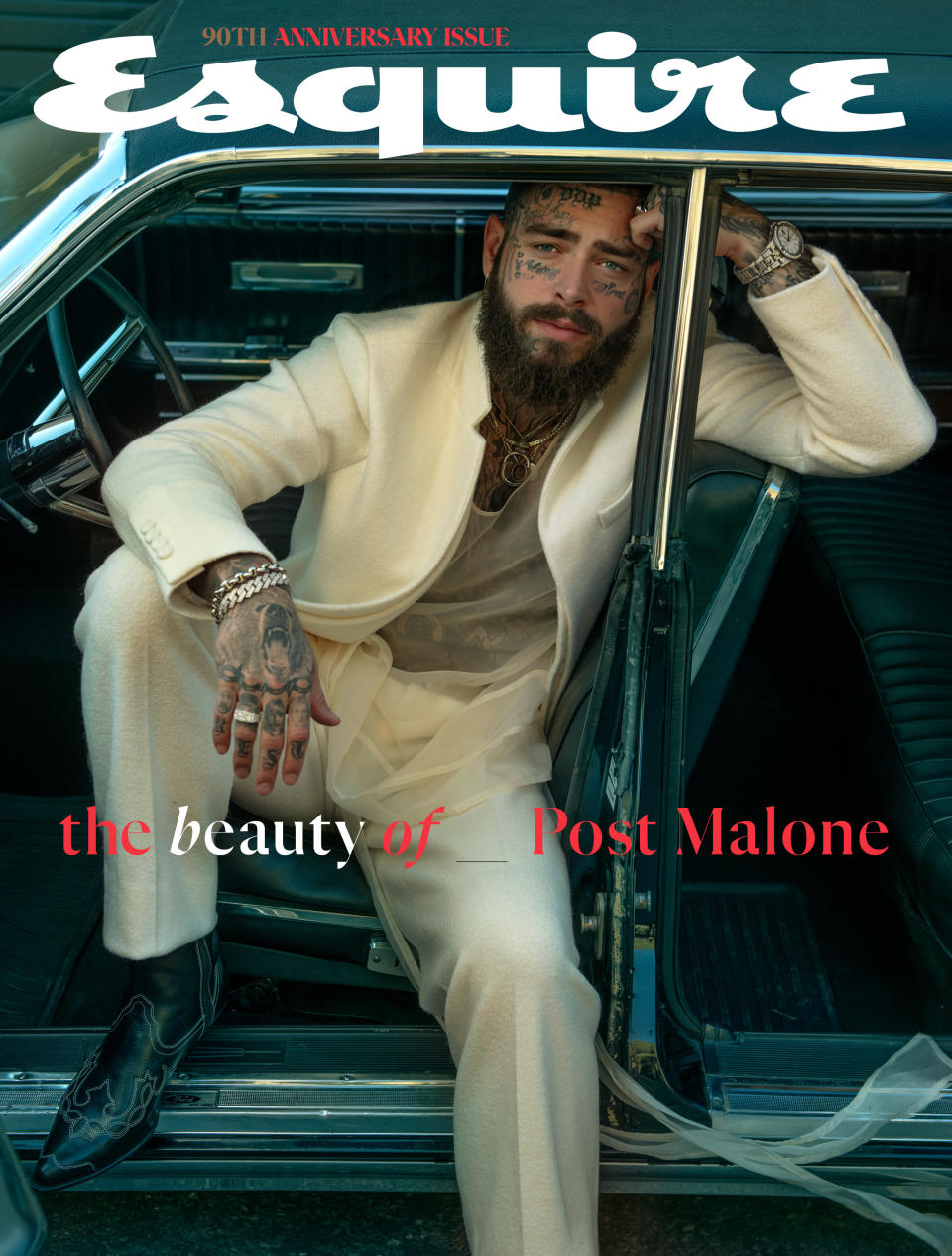Esquire Magazine at 90: Meeting the Moment
- Oops!Something went wrong.Please try again later.

Michael Sebastian is leading a tour of Esquire’s offices on the 28th floor of Hearst Tower. He shows a reporter the archive room, where there are several copies of every Esquire magazine since its first issue in 1933.
“I was born in October 1980,” he says, plucking a copy of that months’ issue from a cardboard magazine box holder.
More from WWD
Rupert Murdoch Steps Down as Chief of Fox Corp. and News Corp.
Graydon Carter on Air Mail's Evolution, Stores and Surviving the Internet
On the cover is a brunette, wearing a hammy grimace and a red Yale T-shirt, and holding a snub-nosed revolver to her right temple next to the headline: “Go Ahead and Shoot! At least you won’t have to put up with any more rotten food, crummy dorms, dopey roommates and jerky profs.” The headline above the masthead promises, “Most Outrageous College Issue Ever.”
It’s not exactly an instant classic; the gun imagery is gruesomely archaic as America’s mass shooting scourge continues apace. But it is representative of the ‘80s era of excess, when over-the-top was just right. And Sebastian — who assumed the editor in chief post after two years as the magazine’s digital director — points out that the issue includes contributions from the likes of James Baldwin, Alfred Kazin and Tom Robbins.
“One of the loadstars for us is that Esquire has always sought to meet the moment,” he says.
“And fundamentally, what that means is that we want to elevate the lives of our readers. So we want to elevate what’s in their closet and what’s on their feet. But we also want to elevate their lives by helping them make sense of this world that they’re living in.”
The current moment for legacy publishers is a challenging one. The digital revolution has made road kill of dozens of magazines, including many in the men’s sector (Details, Maxim). Social media has minted an army of self-styled influencers, who dole out the kind of style and grooming tips that were once the exclusive purview of lifestyle publishers. It has also enabled celebrities (from actors to athletes) to control and disseminate their own stories, bypassing the interpretive voice of a reporter. As Esquire celebrates its 90th anniversary with its October-November issue in the era of racial and gender equity, the question is, how will a men’s magazine evolve to meet this moment?
“Whether by design or not, the Esquire guy was a straight, cisgendered man. And what I was very keen to do was to expand, democratize the idea of who the Esquire guy is. And that includes who we feature on the cover, who we get to write for us, and the points of view that come forward in the issues,” he says.
For its summer 2022 issue, Esquire featured Elliot Page on its cover. The accompanying story was told in the actor’s own words. Ruven Afanador’s seductive, exuberant photos showed Page’s chiseled abs and top surgery scars.
“I didn’t want his story to be told through the filter of a white, cisgender guy like myself,” says Sebastian. “I wanted our readers to have his experience through his own words.”
The piece was a blockbuster. It is the second highest-trafficked cover story, behind the profile of Macaulay Culkin from March 2020. It made international headlines. It also got Sebastian plenty of vile hate mail, including death threats. “Jordan Peterson got kicked off of Twitter, before Elon [Musk] took over, because he had such a freakout over that cover. I view that as kind of a public service,” he says, referring to the inflammatory Canadian psychologist and podcast host.
The interest in the Page story was baked in; it was the Oscar-nominated actor’s first in-depth interview since transitioning. And Sebastian admits that when he assumed the top job, he leaned toward subjects with large social followings, who could bring attention and clicks to Esquire. But, those stories, he says “were often very controlled, very stage-managed.”
And then one day in 2021, he sent writer Ryan D’Agostino to Los Angeles to hang out with Owen Wilson. D’Agostino spent many hours over several days with Wilson. They had a two-hour breakfast, after which they rode bikes to the ballgame of one of Wilson’s sons. The next day they hit L.A. Hydration, where they had IV vitamin cocktails pumped into their arms. They ruminated for hours at a restaurant in Venice Beach until dusk descended.
“Ryan brought back this magnificent story in which Owen Wilson opened up about the darkest parts of his life,” says Sebastian.
A few months later, Esquire profiled Keanu Reeves, who like Wilson, does not do a lot of in-depth interviews and is not on social media.
“That’s when we pivoted a bit in our strategy,” adds Sebastian. “Those are the type of stories we want; the definitive story about that person that also [presents] a version of that person that has never been told before.”
Sebastian, who turns 43 this month, took over as Esquire’s top editor a couple of years into the MeToo movement and a year before racial justice protests began to roil the country. He lives in a tiny town in suburban New Jersey with his wife, a mental health therapist, and their two daughters, ages 8 and 10. They moved from Manhattan during the pandemic, after a devastating fire ripped through their Manhattan apartment. “I did exactly what they tell you not to do,” he says. “I opened the front door.”
There was a wall of flames; he had to carry his youngest daughter out of the burning building under a blanket. It was a traumatic exit from New York City. But he doesn’t seem to harbor any psychic scars from the disaster.
On this day, he is dressed in jeans, a white oxford shirt with the collar buttons unbuttoned and a navy, double-breasted suit with a white chalk stripe. A pencil with a large pink eraser pokes out of the breast pocket of his suit. He exudes a palpable enthusiasm for the magazine he’s been leading since 2019, after Jay Fielden’s abrupt exit. (Fielden left shortly after the revelation that Hearst executives, including now-ousted Hearst Magazines president Troy Young, spiked an investigation into sexual misconduct allegations against director Bryan Singer. Multiple additional editors exited with Fielden and the story later ran in The Atlantic.)

Asked if it was difficult to assume the editorship of the magazine amid such internal and existential angst, Sebastian notes that he was already running Esquire’s digital arm. And a cadre of editors and writers, many of whom he hired, shared his editorial vision. The hardest part for him seems to have been the timing. “I took over in the middle of a September close, at the time, we were also doing Big Black Book [Esquire’s stand-alone style guide]. And so it was a lot of work. And it was not easy. And we were just trying to keep our heads above water.”
Several months later, the pandemic would decimate print and digital advertising revenue as shelter-in-place orders shuttered Hollywood as well as the retail and travel sectors. Since then, Hearst, like many legacy publishers, has undertaken several corporate reorganizations (many of which have resulted in layoffs). And charting a sustainable future has become an uphill slog in a splintered content universe where the old gatekeepers have been supplanted by social media influencers. It’s either innovate or die.
Sebastian and his staff have worked to evolve the magazine’s offerings for a digital audience. He points to Esquire’s first digital cover in January 2023, with Ashton Kutcher. It featured Kutcher putting his cowboy-boot-clad foot through a piece of glass, and it was created specifically for TikTok, where Esquire has approximately 235,000 followers.
But corporate bean counters are keeping a keen eye on budgets.
“It’s a matter of choosing when to shoot your shots essentially,” he says. “I think there’s less waste. There’s probably more rigor. In comparing fat budget times to leaner times, before you may have said, ‘Ah, what the f–k, let’s try it!’ And now it’s like, ‘OK, well, we have data that shows that this kind of story really performs, so we’ll spend the money.’ But maybe we won’t take the risk when we think it’s not going to pay off.”
Esquire now publishes six print issues each year; like many legacy brands, it has seen its print run curtailed. But it has an average print circulation of 620,000 (including subscribers and newsstand sales), according to the Alliance for Audited Media. Esquire.com averages 15 million visitors each month. The magazine’s readership is approximately 60 percent male and 40 percent female. Total ad revenue is up 30 percent year-over-year, with apparel and luxury advertising up 75 and 60 percent, respectively, while e-commerce revenue is up 21 percent. The 90th anniversary issue features three covers: musical artist Post Malone; Yusef Salaam, among the exonerated Central Park Five and now a Democratic nominee for City Council in New York’s 9th district; and Irish actor Barry Keoghan. The issue also includes “The Next 90,” a list of the 90 most influential people, among them, Ukrainian president Volodymyr Zelensky, Kansas City Chiefs quarterback Patrick Mahomes, 26-year-old Florida Congressmen Maxwell Frost and writer and novelist Nana Kwame Adjei-Brenyah (“Friday Black,” “Chain-Gang All-Stars”).
Esquire is a mere decade from its centennial. And its status as an icon in the American magazine canon would seem to go a long way in ensuring its survival. F. Scott Fitzgerald, J.D. Salinger and, most famously, Earnest Hemingway, are among the magazine’s early contributors. Hemingway’s “Snows of Kilimanjaro” was serialized in 28 of the first 33 issues of Esquire. Salinger introduced the character of Holden Caulfield in a 1945 short story first published in Esquire.
“You go through that archive,” says Sebastian, nodding toward the room that holds 90 years’ worth of Esquire issues printed on paper — that stuff made from trees and which legacy publishers have been using less and less of as they negotiate the print-digital divide — “and you pull out an issue, and there’s nothing that defines a moment better than a magazine.”
But Sebastian is taking nothing for granted.
“Oh, you could f–k it up,” he laughs. “I really take seriously my responsibility as custodian of this brand. So when I hand it off to the next generation of editors, it’s even stronger.”
Best of WWD

